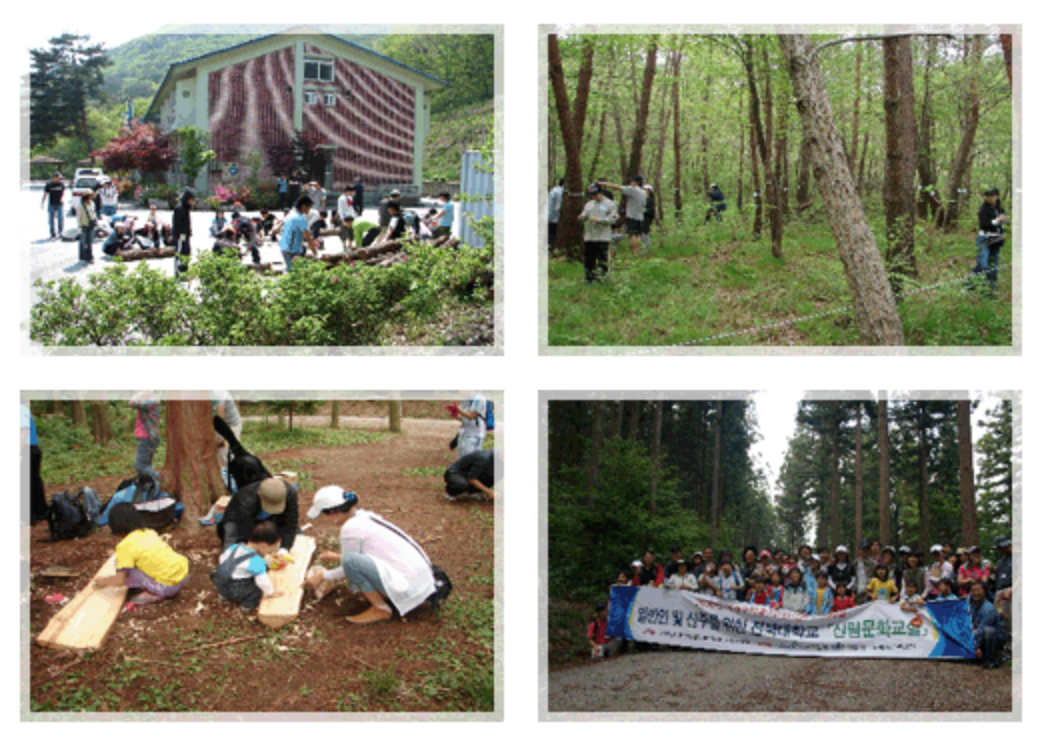About the Department of Forest Environmental Science
Our department is an applied science field where all kinds of productive factors from the forest are dealt with to establish the most ideal forest resources and to achieve effective and rational management of them. By doing so, many contributions will be made to the national economy and protection, public health, recreation and tourism, and so on.
Faculty
- Seo, Byung-Soo
- Professor, Silviculture, Forest Ecology, Ph.D. - Lee, Chang-Heon
- Professor, Environmental Forestry, Forest Recreation, Ph.D - .Park, Chong-Min
- Professor, Forest Engineering, Forest Resources, Ph.D. - Lee, Sang-Hyun
- Professor, Forest Management, Forest Mensuration, Ph.D. - Han, Sang-Sub
- Associate Professor, Forest Protection, Tree pathology, Ph.D. - Kang, Hag-Mo
- Assistant Professor, Forest Policy, Ph.D.
Curriculum
We study various courses such as, Silviculture, Forest Ecology, Forest Protection, Forest Management, Forest Mensuration, Forest Environment Conservation Engineering, Forest Engineering, Forest Policy, Dendrology, Forest Genetics to produce the most competent forest specialists and technology. In addition, fields from silviculture to energy utilization are closely related to human life. As national life is stabilized and improved, the domain of this science needs to be enlarged to strengthen the national economy.
What can I do afterwards
There are many different career options after graduation. They can be grouped into several categories such as, government business, national industry, private industry, and self employed business. In the government business and national industry categories, there are research institutes (Forest Research Inst. and Forest Environment Inst.), Local Forest Management Agencies under the Office of Forestry, Forest Administration positions and Forest Cooperatives, and Nursery Associations in provinces, cities and towns all over the country. In the private industry category, there exist pulp, paper, furniture and seedling related companies. In the final category, there are many creative areas: mountain and field nurseries, landscape tree growing and sale, recreation forests, leisure and tourism, among others.
| Year | Course (Credit) | Year | Course (Credit) |
|---|---|---|---|
| 1-2-ME | Tree Morphology & Practice(3) | ||
| 2-1-M 2-1-M 2-1-M 2-1-ME 2-1-ME |
Dendrology & Practice 1(3) Silviculture & Practice 1(3) Environmental Forestry(3) Forest Surveying & Practice(3) Forest Mensuration & Practice(3) |
2-2-M 2-2-ME 2-2-ME 2-2-ME 2-2-ME |
Forest Environment Conservation(3) Dendrology & Practice 2 (3) Silviculture & Practice 2 (3) Forest Recreation Science (3) Forest Policy (3) Tree Seed Science(2) |
| 3-1-M 3-1-M 3-1-ME 3-1-ME 3-1-ME 3-1-ME |
Forest Environment Conservation Engineering(3) Forest Management & Practice(3) Forest Resource Botany (3) Forest Ecology (3) Garden Trees Management (3) Forest Microbiology (3) |
3-2-ME 3-2-ME 3-2-ME 3-2-ME 3-2-ME 3-2-ME |
Forest Soil Science & Forest Land Fertilization (3) Urban Forest Management (3) Forest Harvesting System (3) Forest Engineering (3) Forest Information System (3) Tree Diseases Diagnosis & Control(3) |
| 4-1-M 4-1-ME 4-1-ME 4-1-ME 4-1-ME 4-1-ME 4-1-ME |
Field Synthetic Practice (1) Forest Genetics (3) Forest Regeneration (3) Forest Recreation Design (3) Computer Aided Forest Design(3) Forest Growth & Yield Modeling(3) Forest Insect Forecast & Control(3) |
4-2-ME 4-2-ME 4-2-ME 4-2-ME 4-2-ME 4-2-ME |
Forest Tree Breeding (3) Special Use Tree Cultivation(3) Wild Life Management (3) Re-vegetation Engineering for Environmental Conservation (3) Forest Economics (3) Forest Mycology (3) |

